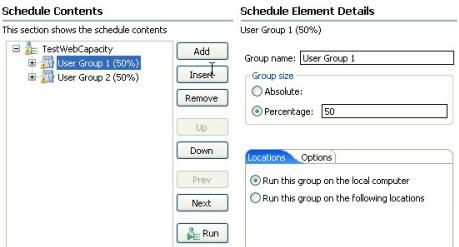User groups
Overview
User groups enable you to group tests in a logical order.

With user groups, you can control test execution in several ways:
| Group tests by characteristics | For example, you could have two user groups—a Buyers group and a Browsers group—that represent the types of users on the system. |
| Influence the order in which tests are run. | When you run a schedule, the first test in each user group runs—in parallel, not sequentially. After the first test in a user group is completed, the second test runs, then the third, and so on. |
The following schedule contains one user group.

If you run this schedule with 10 users, they are assigned to the only user group—Browsers and Buyers. When the schedule run starts, the 10 virtual users start running the first test in parallel. As soon as one test is finished, a virtual user moves to the second test. Thus, you have 10 virtual users, all starting at the same time and running each test sequentially. This does not give you much control over the run.
The following schedule contains the same tests in the same order, but they are divided between two user groups, providing a more accurate representation of the types of users on the system, because each user group contains tests that represent the actions that they do, and the proportions of the user groups (70% and 30%) represent the proportions of the users on the system.

If you run this schedule with 10 users, seven are assigned to the Browsers group, and three are assigned to the Buyers group. When the run starts, the seven Browsers and the three Buyers start in parallel. Thus, you have seven Browsers, each running two tests sequentially, and three Buyers, each running three tests sequentially.
- Add a user group to a schedule
- Adjust user groups
- Emulate slower network traffic
- Run long duration tests
- Run a user group at a remote location
Related:
Schedule overview
Working with agents
Create a schedule
Set user loads
Add a test to a schedule
Assign variables to schedule and user group
Define performance requirements in schedules
Repeat tests in a schedule
Delay virtual users or actions
Run tests at a set rate
Run tests in random order
Add a transaction to a schedule
Synchronize users
Emulate network traffic from multiple hosts
Set log and statistic levels
Related reference:
User group properties
Error 404 - Not Found
The document you are looking for may have been removed or re-named. Please contact the web site owner for further assistance.